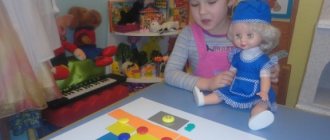Presentation on the topic: Cognitive activity of preschool children
Slide description:
Modern approaches to organizing cognitive activity of preschool children 900igr.net
Slide description:
Cognitive activity is the active activity of acquiring and using knowledge. The task of a child’s cognitive development is to develop the need and ability to think actively and overcome difficulties in solving various mental problems.
Slide description:
There are two main lines in the development of cognitive interests of preschoolers: 1. Gradual enrichment of the child’s experience, saturation of this experience with new knowledge and information about the environment, which causes the preschooler’s cognitive activity.
The more aspects of the surrounding reality that open up to a child, the wider his opportunities for the emergence and consolidation of stable cognitive interests. 2.
This line of development of cognitive interests consists of a gradual expansion and deepening of cognitive interests within the same sphere of reality.
Slide description:
2-3 years. The object of cognition is the surrounding objects and their actions. Children of this age actively explore the world according to the principle: “What I see, what I act with, that is what I learn.”
The accumulation of information occurs through the manipulation of objects, the child’s personal participation in various situations, events, and the child’s observations of real phenomena.
A necessary condition for the activity of cognition is the diversity and changeability of the subject sphere surrounding the child, the provision of freedom of exploration (subject-manipulative play), a reserve of free time and space for unfolding games. 3-4 years.
By this age, children accumulate quite a lot of ideas and knowledge about the surrounding reality. However, these ideas are practically unrelated to each other. The child is only trying to establish relationships between ideas. During this period, the foundations of the aesthetic perception of the world are laid.
Methods of sensory cognition are actively being formed, sensations and perceptions are being improved. The object of cognition becomes not only objects and their actions, but also the characteristics of objects (color, shape, size, physical qualities). This knowledge helps children compare objects and phenomena according to one sign or property and establish relationships of similarity - identity and difference, and carry out classification.
Slide description:
4-5 years. At 4 years of age, the child’s cognitive development moves to another level - higher and qualitatively different from the previous one. Speech becomes a means of cognition. The ability to accept and correctly understand information transmitted through words develops.
Cognitive activity takes on a new form; the child actively reacts to figurative and verbal information and can productively assimilate, analyze, remember and operate with it. Children's vocabulary is enriched with words and concepts. 5-6 years. The older preschooler is already learning about the “big world.”
The basis of a child’s attitude to the world is caring, kindness, humanity, and compassion. Children can already systematize accumulated and received information, through logical operations, establish connections and dependencies, location in space and time.
The sign-symbolic function of consciousness develops, that is, the ability to use signs to indicate actions, signs, and build a model of logical relationships between concepts.
Slide description:
Game is the leading activity of preschool children, on which the entire educational process of a preschool institution is based.
Play for a child is a serious activity in which we create the most favorable conditions for general mental, including intellectual and personal development.
Play is cognitive development, social development, physical development, artistic and aesthetic development, mental development and health.
Slide description:
The organization of cognitive classes depends, on the one hand, on the educational program objectives, and on the other hand, on the content structure of the cognitive activity itself.
Since game motivation in cognitive activity is leading throughout preschool age, a game form of cognitive classes and the active use of game techniques during the lesson are recommended.
Slide description:
Organization of joint cognitive activity of the teacher and children The main forms of organization of children's cognitive activity in this block are didactic and plot-didactic games.
Working with children within this block excludes specially organized classes.
The activity of children can be caused by a teacher who involves them in cognitive and play activities, demonstrating his own passion for it.
Slide description:
Organization of independent cognitive activity of children Within the framework of this block, the creative activity of children develops in cognitive and play activities, free experimentation with various materials. The child gets the opportunity for self-realization.
As part of free independent activity, children master the ability to act in a group of peers, cooperate with them, enter into competitive relationships, and implement elements of a specific children's subculture that are necessary for the child's prosperous existence in the children's community.
The function of the teacher in this block is to create a varied play environment that provides the child with cognitive activity that corresponds to his interests and is developmental in nature.
The environment should also provide children with the opportunity to act individually or together with peers, without imposing mandatory joint activities.
Slide description:
Our children receive the development of cognitive processes - they learn to read, write and count, - they are introduced to creativity and educational work, - they become familiar with beauty, - they love to draw, design and sculpt, - they confidently communicate with peers and adults, - they are actively involved in physical exercises, - they become involved in to a healthy lifestyle.
Slide description:
Thank you for your attention
Source: //ppt4web.ru/detskie-prezentacii/poznavatelnaja-dejatelnost-doshkolnikov.html
Presentation of the educational field “Cognitive Development”
Elena Bogdanova
Presentation of the educational field “Cognitive Development”
Slide 1
I am Bogdanova E.V. teacher of the MBDOU “D/s “Malyshok”. My work experience is 33 years. I'm currently working in 2ml. group
Slide 2
I present to your attention a presentation of the educational field “Cognitive Development”
Slide 3
I would like to start my speech with the statements of famous people:
“The world surrounding a child is, first of all, the world of nature with an endless wealth of phenomena, with inexhaustible beauty. Here, in nature, is the eternal source of children’s intelligence.”
V. A. Sukhomlinsky
“Only that knowledge is lasting and valuable that you have acquired yourself, prompted by your own passion. All knowledge must be a discovery that you have made yourself.”
Korney Chukovsky
Slide 4
Cognitive activity is a conscious activity aimed at understanding the surrounding reality with the help of such mental processes as perception, thinking, memory, attention, speech.
L. S. Vygotsky wrote that mental development expresses something new that is accomplished independently through the new formation of new qualities of the mind and transfers mental functions from a lower to a higher level of development along the lines of voluntariness and awareness.
Slide 5
Relevance: Currently, there is an intensive development of preschool education in different directions: there is an increasing interest in the personality of a preschool child, his phenomenon, the development of his cognitive abilities, which ensure the formation of a holistic picture of the world. In a rapidly changing life, modern man needs not only possession of knowledge, but the ability to obtain it himself, operate with it, think independently and creatively. From birth, a child is already a discoverer, but he himself cannot always find answers to questions of interest. Preparing a child for research activities, teaching the skills of research, becomes the most important task of modern education. For the first time, the Federal State Educational Standard for Education identifies “Cognitive Development” as a separate educational area
Slide6
The goal and objectives are presented on the slide
Slide 7
The educational area “Cognitive Development” contains the following sections of work with children:
Familiarization with the subject environment
Development of cognitive, research and productive activities
Formation of elementary mathematical concepts
Introduction to the social world
Introduction to the natural world
Slide 8 -9
On this and the next slides you see the content of psychological and pedagogical work in five sections of the educational field “Cognitive Development” with children of the second junior group
Development of cognitive-research and productive (constructive) activities
Formation of elementary mathematical concepts
Formation of a holistic picture of the world, broadening one’s horizons
Subject and social environment
Getting to know nature
Slide 10
The educational area “Cognitive Development” successfully integrates with other educational areas:
Social and communicative development
Speech development
Artistic and aesthetic development
Physical development
Slide 11
Cognitive development is present in all types of children's activities
Slide 12
To implement the educational area “Cognitive Development” I use a wide variety of forms of work with children: in the main educational activities I continue to introduce children to their immediate environment, objects in their immediate environment, wild and domestic animals, we continue to get acquainted with color, shape, size, and so on. same with basic mathematical concepts. I also use the following forms of work: reading stories, conversations, discussing what we read, looking at story pictures, watching cartoons, presentations, role-playing games, didactic and theatrical games.
The implementation of educational activities occurs in the process of basic educational activities, during routine moments, during independent activities, in interaction with the families of students. In my work I use such forms of organization as: group, subgroup, individual.
Slide 13
In my work, I try to make maximum use of the authority of the family to consolidate knowledge in the educational field of “Cognitive Development”. Together with parents I conduct entertainment, consultations, surveys, and parent-teacher meetings.
slide 14
A very important condition for cognitive development is a subject-development environment. I pay great attention to creating a subject environment: the group is designed where the necessary gaming material for the development of sensory standards is concentrated. The group has attributes for role-playing games, didactic games and manuals. The kindergarten has a laptop and a multimedia installation, which makes it possible to use ICT in the implementation of the educational field “Cognitive Development”.
Slide 15
In accordance with the Federal State Educational Standard, the necessary conditions are determined for creating a social situation for the development of preschool children.
Slide 16
The following stages of cognitive development are distinguished: Curiosity, inquisitiveness, cognitive interest, cognitive activity
Slide 17
This slide shows the stages of a child’s understanding of the world. Memory, attention, thinking, imagination, sensation, perception lead to the formation of the sensory stage and the stage of logical cognition.
Slide 18 and 19
Here and on the next slide you see the necessary conditions for the formation of curiosity, cognitive interests of children, as well as pedagogical conditions for the successful and full intellectual development of preschool children.
Slide 20 - 21
The Federal State Educational Standard for Preschool Education presupposes the requirements of the basic educational program, which are presented in the form of targets and represent socially normative age characteristics of the child’s possible achievements at the stage of completing the level of preschool education. These slides show early and completion milestones. If we look carefully, these are the achievements that can be achieved by a child in the process of mastering the educational field “Cognitive Development”
Slide 22
on this slide you see some basic concepts of the Federal State Educational Standard for Education for the development of cognitive and research activities
Slide 23
You have now watched an integrated educational activity with children of primary preschool age
based on the fairy tale “Kolobok” using gaming and electronic educational technologies.
You can see the goals and objectives on the slide.
In the main educational activities, I used such methods and techniques as: gaming (finger gymnastics, outdoor game, didactic game) visual (multimedia presentation, verbal (story accompaniment for presentation, method of interest (travel to the forest, use of problem situations (questions, riddles, visual – auditory (listening to music)
In terms of content, OOD is integrated, since its parts are combined with knowledge from several areas. Problem solving is carried out through the following educational areas:
“Cognitive development” (teacher’s story, viewing a presentation, “Speech development” (finger gymnastics) “Social and communicative” (games, element of theatrical performance, “Artistic and aesthetic” (listening to music) “Physical development” (motor activity)
OOD begins with an organizationally motivated moment, where children’s attention is activated and maintained throughout the entire OOD. During the educational activity, children watched a multimedia presentation with narrated slides. The types of activities changed gradually. Children answered questions, played games, solved riddles, and met fairy tale characters. Children were active participants in playful moments during educational activities. Throughout the lesson, I used questions and tasks focused on the zone of proximal development (What to do? What do you think) Children stepped over an imaginary fallen tree. Answered provocative questions (how many ponytails do you have) Collected the picture and found the differences
This allowed us to maintain a positive emotional mood.
Thanks to the elements of theatrical activities, physical activity, gaming activities, and the use of ICT in the implementation of the educational field “Cognitive Development,” I was able to obtain a high-quality level of knowledge for preschoolers in this section. This type of work is carried out with younger children and will become more complicated over time.
Slide 24
In my work I use the following methodological support
Slide 25
Thank you for your attention!






